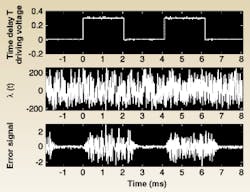Researchers have been making progress toward practical optical encryption systems that exploit laser dynamics. In two recent papers, researchers in France and Japan have shown how feedback-loop-based systems can be best used, and have introduced a new kind of modulation scheme. The separate results demonstrate both the security and ease of decoding of one class of the emerging chaotic-shift keying (CSK) systems, and the applicability of the other to a wide range of systems.
Chaotic-shift keying uses fluctuations in wavelength to encode and hide a communications signal. In an optoelectronic implementation, a laser is configured so that its output fluctuates chaotically—that is, in a deterministic way that nevertheless looks random. To change from one bit value to another (1 to 0 or vice versa) the chaotic mechanism is altered slightly. Because the output is still chaotic, an eavesdropper should not see any change in the transmission. However, the receiver detects that the chaos is sometimes synchronized, sometimes not, allowing the signal to be extracted.
In a collaboration between researchers at Georgia Tech Lorraine (Metz, France) and the Laboratoire d'Optique at the Université de Franche-Compté (Besançon, France), researchers have demonstrated that this system can achieve high-fidelity, high-security recordings. In their system, the researchers use a feedback loop with a nonlinear spectral filter to provide the mechanism for chaotic emission from distributed Bragg reflector lasers (see Fig. 1).1
Three options
The French team wanted to quantify the advantages of changing different parameters to shift from bit to bit. Initially they considered three options: the mean wavelength (around which the chaos was fluctuating), the bifurcation parameter related to the dynamics of the photodetector and laser diode, and the time delay implemented in the feedback loop.
The least sophisticated option is known as masking: essentially a small wavelength modulation signal is hidden in a large chaotic one. This makes it both difficult to decode and somewhat insecure, since the modulation could be detected by an eavesdropper. Tweaking the bifurcation parameter was also inadequate for the encryption application: for more than 50% of bits to be correctly recognized, the mismatch between the bifurcation parameter had to be less than 0.03. For better than 98% masking (high security), the mismatch had to be more than 0.035.
Changing the time delay in the feedback loop, however, was successful. The re-searchers showed that the bit sequence was well-hidden and easily received (see Fig. 2), and the signal could not be decrypted by looking at the signal spectrum or through autocorrelation.Alternative method
In another project, a collaboration between engineers at Takushoku and Keio Universities (both of Tokyo, Japan), researchers chose to use an acousto-optic modulator (AOM) to degrade CSK synchronization for the nonmatched states.2 This approach does not depend on the type of chaotically emitting laser used, so it could be used with semiconductor lasers that have very fast oscillations. For this scheme to work at high speeds, however, the transient time for synchronization—currently 10 times the AOM frequency—will have to be shortened.
REFERENCES
- J.-B. Cuenot et al., IEEE J. Quant. Elect. 37 (7), 849 (July 2001).
- A. Uchida et al., Opt. Lett. 26 (12), 866 (June 15, 2001).

